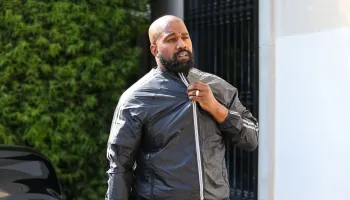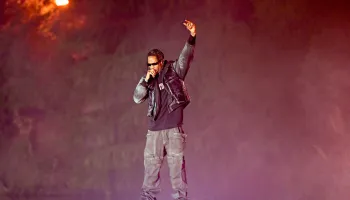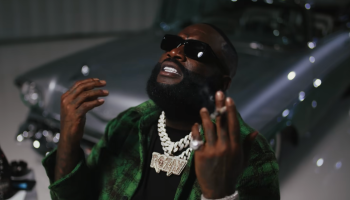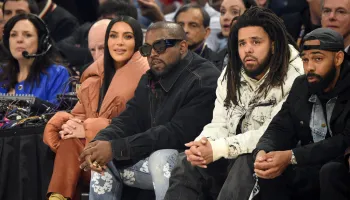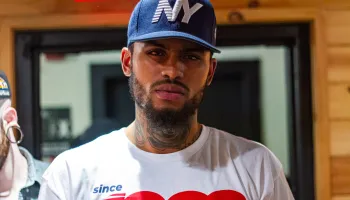
Source: L. Busacca / Getty
There’s a must-watch visual podcast uncovering new ground in the storytelling of The Notorious B.I.G.’s life as he recorded his final album 25 years ago. In Iconic Records: Life After Death, radio legend and executive producer Angie Martinez interviews 25 subjects to transport viewers in a moment of time as a legendary double-sided album was birthed in the midst of his rising fame while navigating a hostile rap beef with the West Coast in the mid-1990s.
While his life has undoubtedly been examined across various media vertices since his violent passing, this 8-episode effort deserves your undivided attention. There’s no overproduction or distractive acting. It involves two chairs, a coffee table, and a camera crew capturing vulnerable conversations between the rapper’s closest friends and colleagues and a radio Hall of Famer. Notables gracing the opposing chair include Rick Ross, Fat Joe, DJ Clark Kent, Lil’ Cease, 112, Pusha T, and more.
The conversations examine the pillars that made Biggie, born Christopher Wallace, an icon as he broke ground in fashion, lyricism, rap politics, recording style, and demeanor. At the time, he was freshly crowned “King of New York” early in his career, becoming a trailblazer in these areas at a heightened level with his unconventional attractiveness during his ascension to fame.
For starters, he was a visual anomaly with a towering stature, big waist, and dark skin, complimented by his smooth charm and lisping charisma– a unique recipe to make the Brooklyn rapper the perfect muse for fashion stylists and photographers who knew he was destined for greatness.
Renowned photographer Barron Claiborne explained how he snapped the legendary red background photographs of Biggie in a crown. The images grew so popular it forced him to repetitively sue bossy Bad Boy Entertainment honcho Sean “Diddy” Combs (f/k/a Puff Daddy) for using the images without his approval. Photographer Michael Levine also discusses the challenges faced to bring us the Life After Death album art taken at the Cypress Hill cemetery.
In episode 4, Klepto, friend and member of the rap group Junior M.A.F.I.A., gives a first-hand account of how he first came across Tupac Shakur witnessing his brotherhood with Biggie during a wild night out on the town. He was also there the day of the Quad Recording Studios shooting, providing the gruesome details of what he saw when he reached the bloody lobby just as the cops intercepted them coming out of the elevator. This incident marked the beginning of the infamous coastal feud between the two rappers, eventually leading to Biggie’s fatal demise a few years later. By episode 5, DJ Clark Kent unapologetically declares Pac’s ominous account of the shooting a blatant lie promoted to avoid telling the truth about what really happened to him that night.
Some of the most famed tracks off Life After Death wouldn’t have happened without sheer networking and dash of humbled begging.“Ten Crack Commandments” producer DJ Premier tells of how the song almost didn’t make it on the album. In this story, Premo highlights that Biggie’s stardom transitioning from gritty New York rapper to Versace wearing superstar (or “ashy to classy” as many here have donned it) caused a bit of friction with his underground artist Jeru the Damja, the original owner of the track. Angie Martinez and her radio show is intertwined in the story, which aided a begging Puffy to eventually procure the instrumental.
In a similar scenario told in episode 6, Fat Joe– a refreshing edition to the series details how intertwined he was in the New York rap scene– recounts the time he brokered the relationship between Biggie and Realitivity Records label mates Bone Thugs-N-Harmony for the track “Notorious Thugs.” The Bronx rapper colorfully embellished a portion of the story of the group’s unwillingness to work with B.I.G. due to their allegience with Pac and the West Coast, which was challenged and denied by Layzie Bone and the group’s manager Steve Lobel. Eventually, Biggie and Bone Thugs united in a historic studio session filled with weed, Hennessy, and positive vibes. Layzie Bone reveals that Biggie didn’t end up recording his part that night, and heard the final version of the song for the first time after the double album was released weeks after his death.
In a later episode, Lil’ Cease continues the story of how seriously Biggie wanted to master the Bone Thugs’ flow and the lengths he took to perfect it before hitting the booth. It’s now one of the most famous songs to date. In all three stories with Pac, Jeru, and Bone Thugs, a common theme about the “Juicy” rapper and his legacy remained consistent: he prioritized his love of music before rap politics.
The series briefly transitions into a therapy session when Lil’ Cease tells of his relationship with his big brother Biggie. Through the trust of his long-standing relationship Martinez, the Junior M.A.F.I.A. member describes the death as a “trauma” he continues to struggle with today. At 44 years old, he introspectively harps on how young he (17) and Biggie (24) were as they both navigated the deep waters of fame and violence.
Nasheem Myrick, a former Bad Boy producer from the legendary Hitmen who worked on “Who Shot Ya,” “What’s Beef?,” and “Somebody’s Gotta Die,” reveals a heartbreaking story of his beef with Biggie over an unknown love interest they both shared at the time. In this untold story, he eventually achieves closure on the last day the rapper was last in New York before flying out to Los Angeles in 1997.
Interestingly, both Lil’ Cease and Klepto separately came to terms with the potential of their own successes had Biggie never passed away. Junior M.A.F.I.A was set to be the next priority for the superstar rapper following the release of Life After Death, but the group never had their chance. Cease also describes how his solo career would have launched under the vision Biggie had for him to be introduced to the world. However, Puff certainly didn’t have an interest in the group after the assassination, especially since their lyrics were mainly penned by Biggie himself. With all considered, the group disbanded leaving fans with classic hits “Players Anthem” and “Get Money” that are still enjoyed today. Meeting the same fate was The Commission comprising of JAY-Z, Lance “Un” Rivera, Diddy, Charli Baltimore, and Lil’ Cease.
Rick Ross and Pusha T also make an appearance on the show. Both Ross, who respectfully mimicked Biggie’s image, and Pusha, a lyricist who faithfully flows about slinging crack, pay homage to how integral Biggie’s music made in their own approach to their discographies.
Noticeably absent from the interview panel were Life After Death featured artists Diddy, The LOX, Lil’ Kim, Ma$e, and Jay Z. It also would have been nice to see Stevie J, another Hitmen producer who had a heavy hand in the making of this album, join the series. It’s unclear if the reality star’s estranged marriage to Biggie’s widow, Faith Evans, had anything to do with that.
Overall, Iconic Records’s first season is, by and large, a great watch thanks in part to the remarkable journalistic executions between host Angie Martinez and director-writer Bonsu Thompson. Without their contribution to this project, it would have been hard to achieve the same high-quality storytelling in someone elses’s hands.
New episodes air weekly across multiple platforms for viewers and listeners alike for free. Binge watch the first 6 episodes on WMX Hip-Hop channel (Ch. 1137) on The Roku Channel or YouTube. Listeners can also access them in a podcast format across all major audio podcast platforms.








